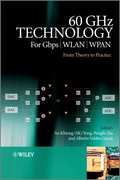
60GHz technology for Gbps WLAN and WPAN: from theory to practice
Yong, Su-Khiong
Xia, Pengfei
Valdés García, Alberto
In this book, the authors focus specifically on 60 GHz wireless technology which has emerged as the most promising candidate for multi-gigabit wireless indoor communication systems. 60 GHz technology offers various advantages over current or existing communications systems (e.g. huge unlicensed bandwidth worldwide, high transmit power, high frequency reuse and small form factor), which enables many disruptive applications that are otherwise difficult if not impossible to be realized at lower frequencies. The book addresses all aspects of the state-of-the-art in 60 GHz technology for high data rate wireless applications INDICE: Preface. 1 Introduction to 60 GHz (Su-Khiong Yong). 1.1 What is 60GHz? 1.2 Comparison with other unlicensed systems. 1.3 Potential applications. 1.4 Worldwide regulatory and frequency allocation. 1.5 Industry standardization effort. 1.6 Summary. References. 2 60 GHz channel characterizations and modeling (Su-Khiong Yong0). 2.1 Introduction to wireless channel modeling. 2.2 Modeling approach and classification of channel model. 2.3 Channel characterization. 2.4 Industry standard channel models. 2.5 Summary. References. 3 Non-ideal RF front-end models in 60 GHz systems (Chang-Soon Choi, Maxim Piz and Eckhard Grass). 3.1 RF front-end architecture. 3.2 Nonlinear power amplifier. 3.3 Phase noise from oscillators. 3.4 Other RF non-idealities. References. 4 Antenna array beamforming in 60 GHz (Pengfei Xia). 4.1 Introduction. 4.2 60 GHz channel characteristics. 4.3 Antenna array beamforming. 4.4 Summary. References. 5Baseband modulation (Pengfei Xia and André Bourdoux). 5.1 Introduction. 5.2 OFDM baseband modulation. 5.3 Case study: IEEE 802.15.3c audio videoOFDM. 5.4 Single carrier with frequency-domain equalization. 5.5 Single-carrier transceiver design and system aspects. 5.6 Digital baseband processing. References. 6 60 GHz radio implementation in silicon (Alberto Valdes-Garcia). 6.1 Introduction. 6.2 Overview of semiconductor technologies for 60 GHz radio. 6.3 60 GHz front-end components. 6.4 Frequency synthesis and radio architectures. 6.5 Radiobaseband interface. References. 7 Hardware implementation for single-carrier systems (Yasunao Katayama). 7.1 Introduction. 7.2 Advantages and challenges of single-carrier systems. 7.3 System design with non-coherent detection. 7.4 System design with differentially coherent detection. 7.5 Test and evaluation. 7.6Advanced single-carrier system with per-packet coherent detection. 7.7 Conclusion. References. 8 Gbps OFDM baseband design and implementation for 60 GHz wireless LAN applications (Chang-Soon Choi, Maxim Piz, Marcus Ehrig, Milos Krstic and Eckhard Grass). 8.1. OFDM physical layer implemented in FPGA. 8.2. OFDM baseband receiver architecture. 8.3 OFDM baseband transmitter architecture. 8.4 60 GHz link demonstration. 8.5 Next-generation OFDM demonstrators for 60 GHzwireless LAN applications. References. 9 Medium access control design (Harkirat Singh). 9.1 Design issues in the use of directional antennas. 9.2 IEEE 802.15.3c MAC for 60 GHz. 9.3 Design considerations for supporting uncompressed video. 9.4 Performance study. 9.5 Conclusions and future directions. References.10 Remaining challenges and future directions (Alberto Valdes-Garcia, PengfeiXia, Su-Khiong Yong and Harkirat Singh). References. Index.
- ISBN: 978-0-470-74770-4
- Editorial: John Wiley & Sons
- Encuadernacion: Cartoné
- Páginas: 304
- Fecha Publicación: 26/11/2010
- Nº Volúmenes: 1
- Idioma: Inglés
